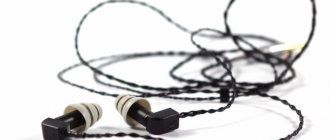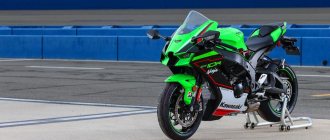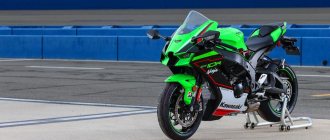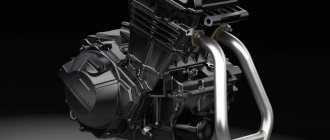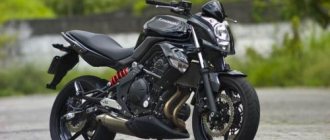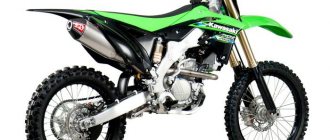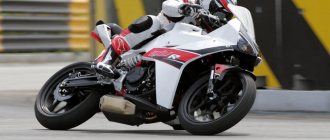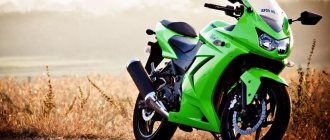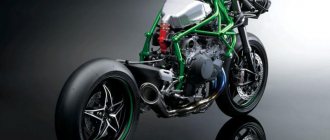| Kawasaki Ninja H2 (2015+) | Kawasaki Ninja H2 Carbon (2017+) | Kawasaki Ninja H2 SX+ SE (2018+) | Kawasaki Ninja H2R (2015+) |
Kawasaki Ninja H2 sports motorcycle model
was announced in 2014, and mass production and official sales started in 2015. This model became the first production sports bike equipped with supercharging. The frame was not the aluminum cast construction used on modern sportbikes, but a steel trellis frame, specially designed and manufactured for the H2 model, which makes it possible to more effectively dissipate heat from the engine. A special robotic welding machine was used to manufacture this frame.
In parallel with the civilian version of the Kawasaki Ninja H2, a racing version was also offered - Kawasaki Ninja H2R
. It was distinguished by boost settings (maximum power - 310 hp), engine, exhaust system, overall and ergonomic parameters, modified gearbox settings and preparation for use on the race track. This model could not be used on public roads.
Among the features of the Kawasaki Ninja H2 (H2R), in addition to the engine and frame, it is worth highlighting sports adjustable suspension, a fuel injection system with dual injectors, powerful front brakes with radial monoblock calipers, a 6-speed gearbox and a number of electronic systems.
- KIBS (Kawasaki Intelligent anti-lock Brake System) ABS
- KCMF (Kawasaki Cornering Management Function)
- KLCM (Kawasaki Launch Control Mode)
- KQS (Kawasaki Quick Shifter)
- Assist & Slipper Clutch
- KEBC (Kawasaki Engine Brake Control)
- KTRC (Kawasaki TRaction Control) - 3-mode, 9-levels
- K-ACT (Kawasaki Advanced Coactive-braking Technology) ABS
- Electronic Throttle Valves
- Cornering lights
- Electronic Cruise Control
- Power Modes
- Smartphone connectivity
- KECS (Kawasaki Electronic Control Suspension)
Kawasaki Ninja H2 Carbon coming for 2021
, featuring carbon fiber body elements and a special silver-mirror matte paint finish.
From 2021, the H2 line will be replenished with a sports-touring modification - Kawasaki Ninja H2 SX
and
Kawasaki Ninja H2 SX SE
. The SX version featured simpler equipment (brake system, reduced width rear wheel), different settings for the engine, injection system and gearbox, as well as a fuel tank increased to 19 liters. The Tourer version was equipped with side panniers. The SX SE modification featured additional options (unlike the regular SX):
- Enlarged windshield
- Heated grips
- More comfortable double saddle
- Color dashboard screen
- Cornering lights - LED lights that automatically highlight turns
- Electronic suspension adjustment KECS (Kawasaki Electronic Control Suspension) - SX SE+ version
For 2021, the H2 version has undergone changes that increase maximum power to 231 hp.
Kawasaki H2 series models are available in most markets including Europe, North America, Oceania and Asia. Only the racing versions of the H2R and the budget H2 SX were available in the Japanese domestic market, although other modifications also came to Japan through re-importation, mainly from Southeast Asian countries.
At the end of 2021, a naked Kawasaki Z H2 was built on the common base of the H2 models.
Brief history of the model
- 2015 - start of production and sales of the model.
Model
: Kawasaki Ninja H2;
Kawasaki Ninja H2R (all regions). Factory designation
: ZX1000NFF; ZX1000PFF.
- 2016 - no significant changes.
Model
: Kawasaki Ninja H2;
Kawasaki Ninja H2R (all regions). Factory designation
: ZX1000NGF; ZX1000PGF.
- 2017 - appearance of the H2 Carbon modification.
Model
: Kawasaki Ninja H2R;
Kawasaki Ninja H2 + Carbon (all regions). Factory designation
: ZX1000YHF; ZX1000XHF.
- 2018 - appearance of the SX modification. The regular H2 version receives minor changes to the engine (maximum power increases to 205 hp).
Model
: Kawasaki Ninja H2 + Carbon;
Kawasaki Ninja H2R; Kawasaki Ninja H2 Carbon; Kawasaki Ninja H2 SX (+ SX SE) (all regions). Factory designation
: ZX1000XJF; ZX1000YJF; ZX1002BJF.
- 2019 - H2 version increases maximum power to 231 hp.
Model
: Kawasaki Ninja H2 + Carbon;
Kawasaki Ninja H2R; Kawasaki Ninja H2 SX (+ SX SE) (all regions). Factory designation
: ZX1002JKF; ZX1000YKF; ZX1002BKF.
- 2020 - no significant changes.
Model
: Kawasaki Ninja H2 + Carbon;
Kawasaki Ninja H2R; Kawasaki Ninja H2 SX (+ SX SE) (all regions). Factory designation
: ZX1002JLF; ZX1000YLF; ZX1002BLF.
- 2021 - no significant changes.
Model
: Kawasaki Ninja H2 + Carbon; Kawasaki Ninja H2R; Kawasaki Ninja H2 SX (+ SX SE) (all regions).
- 2022 - no significant changes.
Model
: Kawasaki Ninja H2 + Carbon; Kawasaki Ninja H2R; Kawasaki Ninja H2 SX (+ SX SE) (all regions).
Engine like an evil snake
I need 2-3 laps to master acceleration, braking, and calm my nerves. Now I can better utilize the potential of the Kawasaki Ninja H2R. The result is visible on the speedometer: I start braking at 332 km/h! The removable Bosch ABS comes into play (it's disabled in the H2) and makes itself felt with just one or two light presses of the brake lever. Kawasaki H2R test participants even spoke of more than 370 km/h.
At this speed, passenger planes take off from the ground. The kawasaki h2r engine is like an angry snake: just get distracted for a minute and it will want to soar into the sky (even on the “four”!). The filigree frame, which looks like it was installed here by mistake, fits the bill well. The steel grille dissipates heat better than the aluminum rear frame with strong side profiles.
Slightly improved Kayaba suspension and 22 kg less weight improve handling. kawasaki h2r
The Brembos do their job superbly - the H2R brakes super effectively without being too harsh. kawasaki ninja h2r
Specifications
Technical characteristics of Kawasaki Ninja H2 (H2R):
| Model | Kawasaki Ninja H2 (H2R) |
| Motorcycle type | sport |
| Year of issue | 2015+ |
| Frame | steel lattice |
| engine's type | 4-cylinder, 4-stroke, in-line, supercharged (2-speed centrifugal supercharger) |
| Working volume | 998 cm³ |
| Bore/Stroke | 76.0 x 55.0 mm |
| Compression ratio | 8.3:1 – Ninja H2R 8.5:1 – Ninja H2 11.2:1 – Ninja H2 SX |
| Cooling | liquid |
| Number of valves per cylinder | DOHC, 4 valves per cylinder |
| Fuel supply system | Injector (DFI), 4x 50mm (dual injectors) – Ninja H2, Ninja H2R Injector (DFI), 4x 40mm (dual injectors) – Ninja H2 SX |
| Ignition type | digital transistor |
| Maximum power | 200.0 hp (147.2 kW) at 11000 rpm – Ninja H2 (2015-2017) 200.0 hp (147.2 kW) at 10,000 rpm – Ninja H2 (Southeast Asia, Thailand) 2015-2017 205.0 hp (150.8 kW) at 11000 rpm – Ninja H2 2018 200.0 hp (147.2 kW) at 10,000 rpm – Ninja H2 (Thailand) 2018 231.0 hp (170.0 kW) at 11500 rpm – Ninja H2 2019+ 171.0 hp (126.0 kW) at 9000 rpm – Ninja H2 (Southeast Asia) 2018+ 200.0 hp (147.2 kW) at 11000 rpm - Ninja H2 SX (Australia, Southeast Asia B3 model, Philippines) 150.0 hp (110.3 kW) at 8000 rpm - Ninja H2 SX (Southeast Asia B1 model) 170.0 hp (125.0 kW) at 9000 rpm – Ninja H2 SX (Thailand) 310.0 hp (228.0 kW) at 14,000 rpm - Ninja H2R 326.0 hp (240.0 kW) at 14,000 rpm - Ninja H2R (with RAM Air inertial supercharging) |
| Maximum torque | 133.5 Nm (13.6 kg*m) at 10500 rpm – Ninja H2 2015-2017 140.4 Nm (14.3 kg*m) at 10,000 rpm – Ninja H2 (South-East Asia, Thailand) 2015-2017 133.5 Nm (13.6 kg*m) at 10,000 rpm – Ninja H2 2018 141.7 Nm (14.4 kg*m) at 11000 rpm – Ninja H2 2019+ 140.4 Nm (14.3 kg*m) at 10,000 rpm – Ninja H2 (Thailand) 2018+ 133.5 Nm (13.6 kg*m) at 9000 rpm – Ninja H2 (Southeast Asia) 2018+ 137.3 Nm (14.0 kg*m) at 9500 rpm - Ninja H2 SX (Australia, Southeast Asia B3 model, Philippines) 128.5 Nm (13.1 kg*m) at 8000 rpm - Ninja H2 SX (Southeast Asia B1 model) 133.4 Nm (13.6 kg*m) at 8500 rpm – Ninja H2 SX (Thailand) 165.0 Nm (16.8 kg*m) at 12500 rpm – Ninja H2R |
| Clutch | Multi-disc in oil bath, hydraulic drive |
| Transmission | 6-speed |
| type of drive | chain |
| Front tire size | 120/70 ZR17 M/C (58W) |
| Rear tire size | 200/55 ZR17 M/C (78W) – Ninja H2 190/55 ZR17 (75W) – Ninja H2 SX 190/65 ZR17 (78W) – Ninja H2R |
| Front brakes | 2 discs, 330 mm, 4-piston radial calipers (KIBS ABS) – Ninja H2, Ninja H2R 2 discs, 320 mm, 4-piston radial calipers (KIBS ABS) – Ninja H2 SX |
| Rear brakes | 1 disc, 250 mm, 2-piston caliper (KIBS ABS) |
| Front suspension | 43mm inverted fork (fully adjustable), 120mm travel |
| Rear suspension | pendulum cantilever with Öhlins TTX36 monoshock absorber (fully adjustable), stroke - 135 mm |
| Motorcycle length | 2085 mm – Ninja H2 2135 mm – Ninja H2 SX SE 2070 mm – Ninja H2R |
| Motorcycle width | 770 mm – Ninja H2, H2R 775 mm – Ninja H2 SX SE |
| Motorcycle height | 1125 mm – Ninja H2 1205 mm – Ninja H2 SX 1260 mm – Ninja H2 SX SE 1160 mm – Ninja H2R |
| Wheelbase | 1455 mm – Ninja H2 1480 mm – Ninja H2 SX SE 1450 mm – Ninja H2R |
| Seat height | 825 mm – Ninja H2 835 mm – Ninja H2 SX SE 830 mm – Ninja H2R |
| Minimum ground clearance (clearance) | 130 mm |
| Acceleration 0-100 km/h (0-60 mph) | 2.6 sec[1] |
| Maximum speed | 299 km/h – with limiter |
| Gas tank capacity | 17.0 l – Ninja H2, Ninja H2R 19.0 l – Ninja H2 SX |
| Motorcycle weight (curb) | 238 kg – Ninja H2 256 kg – Ninja H2 SX 260 kg – Ninja H2 SX SE 216 kg – Ninja H2R |
Furious and technologically advanced KAWASAKI Ninja H2R
The KAWASAKI Ninja H2R, a true engineering marvel, was made possible through the collaboration of several divisions of KAWASAKI Heavy Industries (KHI). This fruitful collaboration has resulted in the introduction of carefully crafted premium components into a world-class superbike equipped with the latest electronics. This created an incredibly powerful motorcycle that is more than worthy of the legendary H2 name.
Unlike the KAWASAKI Ninja H2, which is fully equipped for use on public roads, the KAWASAKI Ninja H2 R, with the prefix R (racing), denotes a motorcycle not intended for urban use. Everything unnecessary was removed from the bike in order to comply with racing regulations and reduce weight. Mirrors, lighting elements and turn signals have been removed. Carbon body parts are designed to achieve ideal aerodynamics; a small spoiler is installed under the head fairing to more evenly distribute air resistance. Small side parts of the body kit help to actively remove heat from the engine, and the double spoiler blades installed on them increase the downforce of the sportbike at high speeds. The bike's unprecedented acceleration and heavy growl from the boosted engine will not soon be forgotten by competitors on the track.
In the photo: the predatory KAWASAKI Ninja H2R (gray)
Engine
The KAWASAKI Ninja H2R powertrain has been designed to be as compact as possible and deliver high power for intense acceleration. At the same time, for successful operation, a highly efficient supercharger was assembled that does not require an intercooler to reduce the temperature of the air supplied to the engine. In addition, this motor is capable of withstanding loads that are twice the maximum permissible for an atmospheric power unit of the same volume. The moment of inertia of the crankshaft is made as low as possible; the crankshaft is combined with a lightweight flywheel to reduce the response time of the power unit to opening the throttles. Dual secondary balancers reduce vibration levels, and the very low rotational mass works in favor of the bike's quick response to rider input. The installed connecting rods also help to achieve the right balance of strength and weight, and the increased diameter of the bolt connection at the crankshaft attachment point is used to ensure a completely secure connection.
The cast pistons used in the design have greater strength at the very high temperatures generated by the engine compared to pistons manufactured using forging technology. The casting process creates hollow areas to achieve the ideal combination of required thickness and strength with reduced weight. A V-groove on the second piston ring prevents movement of the upper piston ring to reduce oil and air consumption. Two oil jets per cylinder contribute to cooling the pistons. One of them washes the entire lower part of the piston, the other washes the piston dome from the exhaust side.
The large, deep oil pan helps cool the lubricant, and the clever design ensures that the oil pump is always surrounded by liquid to prevent cavitation. The unique, carefully designed filter angle and internal design also help prevent oil starvation during heavy acceleration and braking. The high-performance oil pump ensures optimal lubrication of the engine and transmission. The flat top of the piston and the shape of the combustion chamber are borrowed from the field of gas turbine technology, also developed by KAWASAKI.
Pictured: KAWASAKI Ninja H2R engine
During the honing process of the solid upper crankcase and cylinder, a dummy cylinder head is used to ensure the tightest fit of the mating parts after machining. The result is higher-quality processing, with minimal free piston ring clearance and, accordingly, less loss of performance at each engine stroke. The carefully calibrated size of the combustion chamber and high-precision mechanized processing of its surface eliminate the occurrence of shocks and so-called knocking in the engine.
The cylinder head has a water jacket between each cylinder's exhaust ports, large cooling passages around the spark plug wells and valve seats, and overall excellent coolant flow for optimal temperature reduction. Camshafts with high cams and wide valve timing also have a positive effect on the motorcycle's performance.
Engine exhaust valves have poppets made from an extremely heat-resistant alloy called Inconel and heat-resistant tapered stems. Stainless steel is used for the intake valves. Perfectly shaped, polished intake ports are positioned directly opposite the exhaust ports, eliminating unnecessary swirl in the cylinder head.
Supercharger
The centrifugal supercharger designed by KAWASAKI engineers deserves special attention. Its throughput capacity is up to 200 liters of air per second at a speed of up to 99 meters per second, and the maximum pressure is 2.4 atmospheres. The planetary gear receives driving force from the crankshaft and rotates a 69mm impeller, specially developed using expertise from KAWASAKI's gas turbine and aerospace divisions, to reach a speed of nearly 130,000 rpm. With this highly efficient design, the air passing through the supercharger does not heat up, eliminating the need for an intercooler. The straight, bend-free air intake seamlessly feeds air directly into the supercharger without reducing the bike's power at this important stage.
An aluminum chamber located between the supercharger housing and the throttle valves assists in heat exchange, keeping the incoming air flow cool. Stainless steel meshes installed above the intake channels condense fuel from the secondary injectors on themselves and lower the temperature of new portions of the fuel-air mixture with this condensate. An electronically controlled dump valve regulates the increase in pressure in the intake chamber when the throttle valve is closed to prevent unwanted impeller flex and vibration. Stainless steel pipes of elliptical shape (in accordance with the valve outlets) with a diameter of 45 mm of the exhaust manifold pass into round pipes, and then into a small volume pre-chamber located under the engine to reduce exhaust noise.
Pictured: KAWASAKI Ninja H2R intake tract
Frame
The chassis design had to be robust enough to cope with the powerful engine and effectively absorb external disturbances at speed. The trellis frame of the motorcycle is made of high-strength steel, while the thickness and bending of each element are carefully selected to provide the necessary rigidity to the entire device. Balanced rigidity and springiness of the supporting structure help the rider control the bike when riding at high speeds. The bike's slim waist and horizontally mounted cast aluminum swingarm allow riders to sit comfortably in the saddle and lift their feet off the pegs during stops. The open design of the trellis frame allows air to flow through it, dissipating engine heat. The swingarm is attached directly to the rear of the engine, thereby introducing the power unit into the supporting structure of the motorcycle. This solution eliminated the installation of additional crossbars and yokes, saving weight and allowing for optimal placement of the chain drive on the rear wheel.
Transmission
The six-speed gearbox with improved lubrication system used in MotoGP also uses another useful technology borrowed from the world of racing. Gears fixed to the input shaft are moved by rings to engage gears on the secondary shaft. The result is crisp, quick shifting that is more intuitive for the rider. The multi-disc oil-bath clutch is equipped with a friction clutch for easier shifting and the possibility of slipping when the rider suddenly shifts gears.
Suspension
The new Uni-Trak monoshock absorber manufactured by the famous company Öhlins, model TTX36, has a gas shock absorber, a compensation reservoir, and spring preload adjustment. The patented shock absorber features a unique coaxial twin-tube design and a carbide main piston that only moves oil in the cylinder. The damping components are located at the top between the cylinder head and the reservoir. The simple mechanism allows the elements to have less weight, providing very consistent damping. Because the shock absorber's design makes it virtually immune to cavitation, the gas pressure is only half that of a standard shock absorber, so less stress is placed on the sealing elements. Separate channels connect the compression and rebound valves, allowing the use of separate regulators. This helps in tuning the suspension due to the fact that changing one parameter does not affect the condition of another. Compression and rebound adjustments can be made manually, without the use of special tools, and the shock absorber spring is preloaded in the same way.
Pictured: Uni-Trak Öhlins TTX36 shock absorber
The Kayaba AOS-II (Air-Oil Separate) 43mm front fork features dual chambers to separate air-oil damping for a more consistent performance. The fork provides smooth initial action and strong resistance at the end of the stroke. DLC (Diamond Like Carbon Coating) coating on the inner tubes reduces surface bonding for improved fork response and helps prevent wear.
Brakes
The front brakes are equipped with Brembo radial cast monobloc calipers with four 30mm pistons, which, together with huge 330mm Brembo discs, guarantee excellent stopping power. The outer edges of the discs are grooved to help dissipate heat. The master cylinder and pump reservoir are calibrated so that even slight movement of the handle transmits powerful force to the front brake. The Brembo rear brake caliper is equipped with two pistons, each 32 mm, and the diameter of the brake disc is 250 mm. The high-precision ABS system provides smooth feedback and minimal lever movement to reduce speed.
The ECU interacts with the compact ABS electronic unit (which controls wheel speeds and front caliper pressure) to provide highly precise brake pressure control. This means that the feeling of the brakes is not weakened, only sharp shocks and impulses on the handle, inherent in simpler ABS systems, are eliminated.
In the photo: driving a Ninja H2R sportsbike
The rider's position in the saddle is optimized for high-speed riding on the track. The forward tilt of the body has been reduced, the handlebars have been slightly widened, and the footpegs have been moved 10 mm forward. The single seat tapers at the front to ease the feet on the ground and widens at the rear to support the rider. The compact rear fairing has adjustable side supports to help maintain the rider's position during intense acceleration.
The compact digital instrument panel with analog tachometer does not clutter up the pilot's cockpit. An interesting feature was the backlit indicator of the number of revolutions when the tachometer needle passes through it. All instrument panel functions are accessible via compact switches located on the steering wheel.
